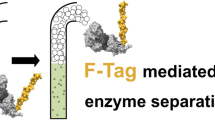Abstract
Foam fractionation isone of the low operating-cost techniques for removing proteins from a dilute solution. The initial bulk solution pH and air superficial velocity play an importantrole in the foam-fractionation process. Denaturation of proteins (enzymes) can occur, however, during the foamfractionation process from the shear forces resulting from bursting air bubbles. At the extreme bulk solution pHs (lower than 3.0 and higher than 10.0), the en zymatic activity of cellulase in the foamate phase drops significantly. Within these two pH boundsan increase in the air superficial velocity, Vo, and a decrease in the bulk solution pH leads to a decrease in the separation ratio (SR), defined as theratio of the protein concentration in the foamate to the protein concentration in the residue. On the other hand, an increase in Vo provides a higher foamate-protein recovery. The process efficiency is defined as the product of foamate-protein recovery times the SR times the cellulase activity. The optimal operating condition of the cellulase foamfractionation process is taken into account at the maximum value of the processefficiency. In this study, that optimal condition is atan air superficial velocity of 32 cm/min and a bulk-solution pH of 10.0. At this condition, the recovered foamate is about 80% of the original protein mass, the SR is about 12, and the en zymatic activity is about 60% of the original cellulase activity.
Similar content being viewed by others
References
Montero, G. A., Kirschner, T. F., and Tanner, R. D. (1993), Appl. Biochem. Biotech. 391/40 467–475.
Ko, S., Loha, V., Prokop, A., and Tanner, R. D. (1997), Appl. Biochem. Biotech. 70/72, 547–558.
Kunas, K. T. and Papoutsakis, E. T. (1990), Biotechnol. Bioeng. 36, 476–483.
Wright, K. I. T. and Cui, Z. F. (1994), in Separations for Biotechnology, Pyle, D. L., ed., vol. 3, The Royal Society of Chemistry, London, UK, pp. 579–585.
King, K. W. and Vessal, M. I. (1969), in Cellulase and Their Applications, Hajny, G. J. and Reese, E. T., eds., American Chemical Society, Washington, DC, pp. 7–26.
Saha, B. C. and Bothast, R. J. (1997), in Fuels and Chemicals from Biomass, Saha, B. C. and Woodward, J. eds. American Chemical Society, Washington, DC, pp. 46–56.
Bradford, M. M. (1976), Anal. Biochem. 72, 248–254.
Mandels, M., Andreotti, R., and Roche C. (1976), in Biotechnology and Bioengineering Symposium, No. 6, Gaden, E. L., Jr., Mandels, M. H., Reese, E. T., and Spand, L. A., eds., Wiley, New York, pp. 21–23.
Miller, G. L. (1959), Anal. Chem. 31, 426–428.
Loha, V., Nun, S. N., Sarkawi, S. S., Prokop, A., Tanner, R. D., and Vitolo, M. (1998), Partitioning cellulase between a dilute water solution and generated droplets, Revista de Farmácia e Bioquímica da Universidade de São Paulo.
Author information
Authors and Affiliations
Corresponding author
Rights and permissions
About this article
Cite this article
Loha, V., Prokop, A., Du, L. et al. Preserving the activity of cellulase in a batch foam fractionation process. Appl Biochem Biotechnol 79, 701–712 (1999). https://doi.org/10.1385/ABAB:79:1-3:701
Issue Date:
DOI: https://doi.org/10.1385/ABAB:79:1-3:701




